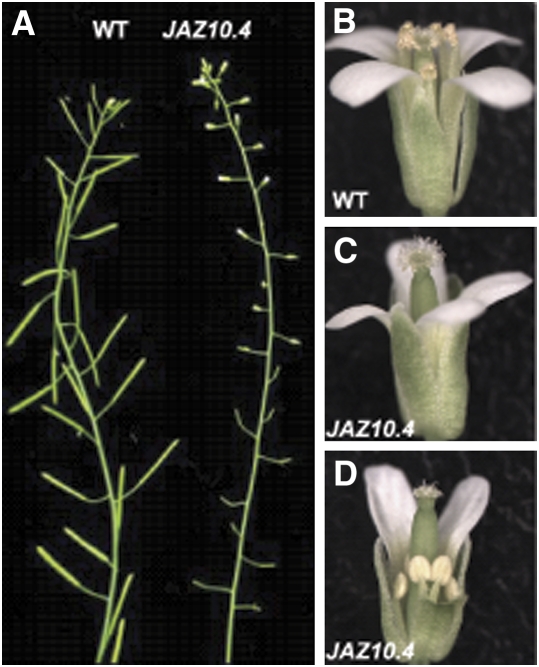As the old song goes, “You've got to accentuate the positive, eliminate the negative,” and that is what happens in the plant response to the hormone jasmonic acid (JA). In this case, the task of eliminating the negative falls to the ubiquitin-meditated protein degradation pathway, specifically the E3 ubiquitin ligase component CORONATINE INSENSITIVE1 (COI1). In response to JA, COI1 targets the negative regulators JASMONATE ZIM-domain (JAZ) proteins to be destroyed (reviewed in Chico et al., 2008; Staswick, 2008). This turnover accentuates the positive basic helix-loop-helix transcription factor MYC2 by releasing it from its inhibitory interaction with the JAZ proteins. Of course, JA signaling is not as simple as an old song: one of the positive responses induced by treatment with JA is an increase in production of JAZ proteins.
Arabidopsis has 12 proteins in the JAZ family; these are characterized by two conserved protein motifs, the ZIM and Jas domains. The ZIM domain of JAZ proteins contains the conserved TIFY motif (TIFF/YXG) and is present in other plant proteins. The Jas domain is specific to JAZ proteins and is required for protein breakdown in response to JA; indeed, overexpression of engineered JAZ proteins that lack the Jas domain causes a dominant JA-insensitive phenotype, including male sterility and JA-resistant lengthening of roots.
Chung and Howe (pages 131–145) examined Arabidopsis JAZ proteins and found that they interact, forming both homo- and heterocomplexes; moreover, this interaction was abolished by mutation of the TIFY motif in the ZIM domain. Concentrating on one JAZ family member, JAZ10, the authors identified an alternative splice form of the JAZ10 transcript. Previous work had identified other splice forms that produce full-length (JAZ10.1) or partially truncated (JAZ10.3) proteins; the newly identified form (JAZ10.4) produced a JAZ10 protein with a complete deletion of the Jas domain. JAZ10.4 failed to bind COI1 but could still bind to MYC2 and to other JAZ proteins. Overexpression of the JAZ10.4 form gave JA-resistant root growth and a strong male-sterile phenotype (see figure) that was not rescued by exogenous JA. This overexpression phenotype was abolished by mutation of the TIFY motif in JAZ10.4. Importantly, the JAZ10.4 form is not destroyed in response to JA. Thus, the JA response, in addition to accentuating the positives, produces some negatives that cannot be eliminated by COI1-mediated destruction, thereby tempering the hormone's action.
Figure 1.
Overexpression of JAZ10.4, which lacks the Jas domain and thus is not broken down in response to JA, gives a male-sterile phenotype.
References
- Chico, J.M., Chini, A., Fonseca, S., and Solano, R. (2008). JAZ repressors set the rhythm in jasmonate signaling. Curr. Opin. Plant Biol. 11 486–494. [DOI] [PubMed] [Google Scholar]
- Chung, H.S., and Howe, G.A. (2009). A critical role for the TIFY motif in repression of jasmonate signaling by a stabilized splice variant of the JASMONATE ZIM-domain protein JAZ10 in Arabidopsis. Plant Cell 21 131–145. [DOI] [PMC free article] [PubMed] [Google Scholar]
- Staswick, P.E. (2008). JAZing up jasmonate signaling. Trends Plant Sci. 13 66–71. [DOI] [PubMed] [Google Scholar]



